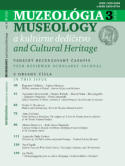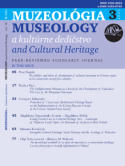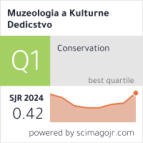

MUZEOLÓGIA
MUSEOLOGY
a kultúrne dedičstvo
and Cultural Heritage

News
Journal Muzeológia a
kultúrne dedičstvo -
Museology and Cultural
Heritage:
SJR 2024: 0,424 (Q1)
Museology SJR rank: 8/83 (Q1) Conservation SJR rank: 11/103 (Q1)JIF WoS 2023: 0,6
JCI WoS 2023: 1,28, Q1 ESCI: 49/411 (Q1)New issue
Muzeológia a kultúrne
dedičstvo 1/2025
online New volume Studia Museologica Slovaca, vol. 8 (2024) online New volume Populačné štúdie Slovenska 17 (2024) onlineNew book
P. Tišliar (ed.). Osobnosti uměleckoprůmyslového muzejnictví (2025). online
Contents 3/2024
Title: Possibilities and limits of development of technical museums in Ostrava region in the
nineteenth–twenty-first centuries
Abstract: The paper analyses the ways in which the idea of the technical museum developed in the industrial region of Ostrava in the
course of the nineteenth and twentieth centuries. The issue is determined by political, economic and cultural changes in the following
time periods: from the end of Austro-Hungarian monarchy (until 1918); the first Czechoslovak Republic (1918–1938); WWII
(1938–1945); post-war development, the so called Third Republic (1945–1948); the communist era (1948–1989); and from 1989 to the
present. The development was always determined by whether the idea of the regional technical museum was interesting to powerful
and intellectual elites, and what the response was from broader society – hence the significance of newspaper articles and other
period reflections of the situation.
Authors: Šopák, Pavel1
Publication order reference:
1Brno University of Technology, Faculty of Architecture, Poříčí 273/5, 639 00 Brno, Czech Republic, e-mail: sopak@vutbr.cz, https://orcid.org/0000-0001-8763-
2817
Source: Muzeológia a kultúrne dedičstvo, year: 2024, vol.: 12, issue: 3, pages: 5-16.
Key words: technical museum, heavy industry, Ostrava region, cultural identity
Language: English
online full-text PDF
doi: 10.46284/mkd.2024.12.3.1
Title: The Enlightenment Museum as a Result of the Development of Education: The Case of the
Musaeum Polonicum
Abstract: The article presents the concept of the Musaeum Polonicum, developed in 1775 and published in the magazine Zabawy
Przyjemne i Pożyteczne. Its author, Michał Jerzy Wandalin Mniszech (1748–1806), was an intellectual educated in the spirit of the
European Enlightenment, involved in the scientific, cultural and political life of the Republic of Poland. He planned the museum as a
didactic base for the academy of sciences and arts. The collection was to have a distinct national character, with educational and
research functions. It was divided into groups corresponding to the Enlightenment classification of sciences. In the history of Polish
museology, the Musaeum Polonicum was the first initiative to establish a national museum, although the project was ultimately not
implemented.
The research methodology was based on the classical historical approach of studying source texts, while taking into account the
research perspectives of contemporary museological discourse. Archival materials representing two thematic groups were analysed:
early museological texts which applied in the cultural area of the Republic of Poland in the second half of the eighteenth century, and
texts related to Polish education and schooling. The results of these analyses are set in a European context. The aim of the article is
to introduce a new research perspective to historical museology and the history of collecting. Its main assumption concerns the
treatment of Enlightenment museums as a result of the development of education.
Authors: Paul, Paulina1
Publication order reference:
1 University of Warsaw, Faculty of Education, ul. Mokotowska 16/20, 00-561 Warsaw, Poland, e-mail: paulina.paul@uw.edu.pl, https://orcid.org/0000-0001-
5129-7973
Source: Muzeológia a kultúrne dedičstvo, year: 2024, vol.: 12, issue: 3, pages: 17-32.
Keywords: : concept of the Musaeum Polonicum, Enlightenment museum, didactic collection, scientific collection, Polish museology,
historical museology, theoretical museology
Language: English
online full-text PDF
doi: 10.46284/mkd.2024.12.3.2
Title: Protection of Visual and Architectural Heritage Based on the Implementation of he Living
Museum Concept in the Cracow Stained Glass Factory
Abstract: This article focuses on the concept of a living museum based on the Stained Glass Factory in Cracow. It examines how
such a museum can integrate elements of real life into the exhibition, creating a unique experience for visitors. By examining the
intersection of traditional craftsmanship and contemporary engagement strategies, the paper delves into the potential of revitalising
cultural heritage. The study investigates the impact of such a concept on preserving and promoting the rich legacy of stained glass
artistry, providing insights into the viability and enriching potential of this concept for both the local community and visitors. The
conducted research also aims to trace the historical significance of stained glass in Cracow’s architecture and how the museum
concept affects the dissemination of this knowledge.
Author: Schnotale, Grzegorz1
Publication order reference:
1 Cracow University of Technology, Faculty of Architecture, Department of Drawing, Painting and Sculpture, Cracow, Poland, e-mail:
grzegorz.schnotale@pk.edu.pl, https://orcid.org/0000-0002-3183-8258
Source: Muzeológia a kultúrne dedičstvo, year: 2024, vol.: 12, issue: 3, pages: 33-42.
Keywords: living museum concept, stained glass factory and museum, museum architecture, experience for visitors, visual heritage
Language: English
online full-text PDF
doi: 10.46284/mkd.2024.12.3.3
Title: Losing Genius Loci in Cultural Heritage Sites – Landscape of Defensive Castle Open-Air
Museums of the Jurassic Belt, Poland
Abstract: Cultural heritage gives places meaning and an atmosphere called genius loci based on tangible and intangible values.
Nowadays, we can observe a commercial and consumerist approach to the spirit of place: it is used as a promotional tool and a
tourism product, reduced to a cliché satisfying popular consumers tastes. The aim of this study is to identify the values which
determine the identity of a place and the dangers they face, trying to answer the question: how can genius loci be protected? We
analyse the problem based on the example of selected open-air museums at defensive castles in Poland’s Jurassic Belt. These
museums have become a field of commercial entertainment and fallen victim to irreversible transformations.
Authors: Żmudzinska-Nowak, Magdalena1; Wałek, Magdalena2
Publication order reference:
1 Silesian University of Technology, Faculty of Architecture, 7, Akademicka Street, 44-100 Gliwice, Poland, e-mail: magdalena.zmudzinska-nowak@polsl.pl,
https://orcid.org/0000-0002-9323-0272
2 Silesian University of Technology, Faculty of Architecture, 7, Akademicka Street, 44-100 Gliwice, Poland, e-mail: magdalena.walek@polsl.pl,
https://orcid.org/0000-0002-5527-6755
Source: Muzeológia a kultúrne dedičstvo, year: 2024, vol.: 12, issue: 3, pages: 43-62.
Keywords: genius loci, cultural heritage, tangible and intangible values, open-air museum, tourism
Language: English
online full-text PDF
doi: 10.46284/mkd.2024.12.3.4
Title: Intangible Cultural Heritage: Social Memory and the Axiology of Protection
Abstract: Traditional culture and values are the axiological foundation of states. Folk culture and folklore can be considered the
cornerstone of national heritage. This article analyses the actions taken by UNESCO which contributed to the crystallisation of a
multilateral international agreement that, for the first time in history, covered the conservation of intangible cultural heritage. The
article’s main research hypothesis is the statement that cultural heritage is an axiological mirror of civilisation, as well as the basis for
the existence and development of society. This is connected with a more detailed thesis that the intangible manifestations of culture
are the source of living heritage of humanity and carriers of values. Since cultural heritage encompasses manifestations of various
cultures’ activities and creativity, the comparative method was also used. The research findings show that supporting cultural diversity
plays an important role in building interpersonal solidarity in the spirit of dialogue, mutual trust and cooperation. Respect for intangible
cultural heritage is a guarantee of peace and security internally and from an international perspective.
Authors: Kowalska, Samanta1
Publication order reference:
1 University of Kalisz, Faculty of Law, Institute of Legal Sciences, Poland, e-mail: s.kowalska@uniwersytetkaliski.edu.pl, https://orcid.org/0000-0002-8803-3901
Source: Muzeológia a kultúrne dedičstvo, year: 2024, vol.: 12, issue: 3, pages: 63-75.
Keywords: intangible cultural heritage, international law, cultural diversity, “living” books, ethics of protection
Language: English
online full-text PDF
doi: 10.46284/mkd.2024.12.3.5
Title: An operational windmill in an open-air museum as a conservation challenge: Lessons from
projects recently implemented in Poland
Abstract: The article discusses the methods of protecting historic windmills and recognising them as valuable objects of industrial
heritage. Therefore, examples of attempts to restore windmills as working mills after 2010 are discussed. Translocation combined with
comprehensive renovation can be an effective and desirable method of conservation for historic windmills with a wooden structure, as
it enables the restitution of these facilities as operating mills. However, one should be aware of the risks associated with this type of
activity: primarily the risk of losing the historic, original substance of the mill and changing its landscape context. An important problem
is the safety of the dynamic exhibition and the lack of professionals – millers specialised in the field of drive mills, who would be able to
not only set up the technological process but also maintain the machines included in it on an ongoing basis. The following part of the
article discusses 12 examples of attempts to restart historic windmills. These examples are divided into two categories of objects:
windmills with an alternative, modern electric drive; windmills with the ability to work using only wind power. The analysed examples of
windmill conservation and reactivation provide the basis for formulating lessons for future projects in Poland and abroad.
Authors: Tomaszewski, Filip1; Walczak, Bartosz M.2
Publication order reference:
1 Institute of Architecture and Urban Planning, Al. Politechniki 6, 93-590 Lodz, Poland, e-mail: filip.tomaszewski@p.lodz.pl, https://orcid.org/0000-0001-7700-
0760
2 Institute of Architecture and Urban Planning, Al. Politechniki 6, 93-590 Lodz , Poland, e-mail: bartosz.walczak@p.lodz.pl, https://orcid.org/0000-0002-9429-
9626
Source: Muzeológia a kultúrne dedičstvo, year: 2024, vol.: 12, issue: 3, pages: 77-99.
Keywords: windmill, milling technology, reactivation, industrial heritage conservation
Language: English
online full-text PDF
doi: 10.46284/mkd.2024.12.3.6
Articles (Abstracts)

Full-text version
DOI:10.46284/mkd.2024.12.3.0
ISSN 1339-2204
eISSN 2453-9759
EV 1/22/EPP
Vol. 12 (2024), No. Is. 3



























